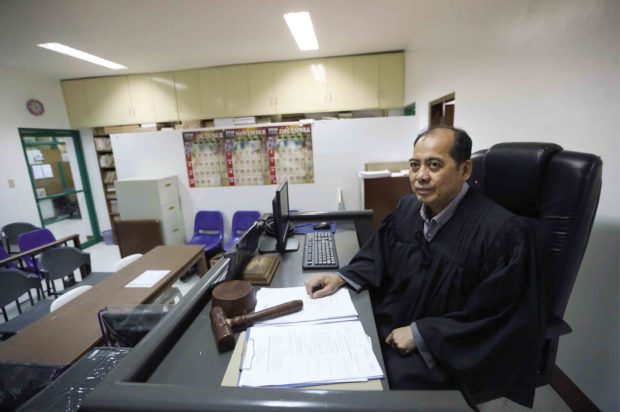
JUDGES’ TRIALS Apart from dockets overflowing with cases and the lack of courtrooms, Judge Felix Reyes, of the Marikina Regional Trial Court Branch 272, says judges face serious concerns over their safety. In all, 29 judges have been killed since 1999 across the country. —LYN RILLON
It was a scene truly out of the ordinary: Due process being exercised in a series of trials on the sidewalk outside the Hall of Justice in Santa Cruz, the capital town of Laguna province.
Under the noonday sun, Presiding Judge Suwerte Ofrecio-Gonzales and the court staff of Regional Trial Court (RTC) Branch 6 were all business as usual.
It was a clear showcase that justice, though often slow on its wheels, must continue to roll.
The shortage of courtrooms and proper facilities, however, is just one of the issues faced by RTCs in the country.
As thousands of cases flood their dockets, so do the challenges for over 900 RTC judges in the country, according to the Philippine Judges Association (PJA).
Judge Felix Reyes, the PJA president, said that in an effort to decongest dockets, new courts were already being created.
“But the problem is other things take time, such as the budget allocation and appointment of judges,” he said in an interview. “Then sometimes, a judge had already been appointed, but there are no staff.”
80-90% drug cases
A master list of incumbent judges by the Judicial and Bar Council shows that many RTC branches remain vacant and unorganized in several cities across the country.
Despite having around 900 judges, Reyes said the number was still not enough to swiftly finish trials in many courtrooms flooded with cases.
He noted that at present, at least 80 to 90 percent of the cases being handled by courts were related to illegal drugs, the numbers exacerbated by the oft-criticized war on drugs under the Duterte administration.
29 slain since ’99
The PJA, the lone association of RTC judges recognized by the Supreme Court, has the daunting challenge of calling for the improvement of court facilities and pushing for the construction and maintenance of the halls of justice in the country, said the Marikina City judge.
But beyond infrastructure, judges also face concerns over their safety, Reyes said.
Based on PJA’s monitoring, 29 judges—mostly assigned in RTCs—have been killed since 1999.
Most of those killings have remained unsolved, with no perpetrators charged and placed behind bars—a cruel irony for the men and women of the judiciary.
Under the Duterte administration, three RTC judges have been killed, the most recent of whom was Ozamiz City Judge Edmundo Pintac, who was shot dead by motorcycle-riding assailants in October.
Pintac handled the charges of illegal possession of drugs and firearms against the Parojinog siblings, Nova Princess and Reynaldo Jr. They were arrested in a predawn raid in July in their home, where their father Mayor Reynaldo Parojinog Sr., mother Susan, aunt Mona and 11 other people were killed after allegedly engaging in a shootout with policemen.
Reyes said the PJA had already suggested to Congress the creation of the Philippine Marshal, a law enforcement agency that would provide protection for members of the judiciary.
Handling threats
But unlike the US Marshals Service, which is under the justice department, the Philippine Marshal will be under the Supreme Court, he said.
“The Supreme Court en banc is now planning to hire a consultant … to help in the possible legislation that will create this,” Reyes said. “In the meantime, the SC will create a pool of trained [personnel] who will be responsible for the security of the judges and justices.”
This pool, he said, could also address death threats to judges handling high-profile cases. Under a Supreme Court circular, the high tribunal also can assign a security detail for these high-risk judges.
But Reyes said these security staff were often untrained to deal with dangerous situations.
In the absence of a law, he said, they can still request for the assistance of the Police Security and Protection Group.
Reyes has expressed alarm over the frequency of the killings, which he believes are mostly work-related.
‘Seemingly ordinary’
“The Supreme Court is already addressing the situation … But there is this question on why it is now seemingly ordinary to kill judges,” he said.
Over the last six years, the PJA has also been clamoring for hazard pay for judges. “This is not a deterrent per se,” Reyes said.
Progress on this request has been snail-paced, though, as the source of funding has always been problematic.
Despite these challenges, coupled with issues that have recently rocked the country’s judiciary, Reyes said he remained hopeful that the government branch would continue to move forward.
SC efforts
Significant efforts by the Supreme Court to decongest dockets have been implemented, such as mediation, plea bargaining and judicial dispute resolutions.
For instance, plea bargaining—where an accused pleads guilty to a lesser charge in return for reduced jail sentences and lower fines—has resulted in the reduction of congested court dockets by at least half.
“We want to let people know that there is justice and they can expect it from the judiciary,” Reyes said. “It’s not easy to be a judge and we, too, get a lot of complaints about our work … But I hope that we keep our faith in the judiciary.”